General Topics
Maintaining the health of the primary teeth is very important. Untreated cavities can, and often do, lead to problems that affect developing permanent teeth. Primary teeth are important for :
- proper chewing and eating
- creating space and guiding the permanent teeth into the correct position, and
- permitting the jaw bones and muscles to develop normally.
Primary teeth also impact speech development and add to an attractive appearance. Children have their front 4 teeth until 6-7 years of age. The back teeth (cuspids and molars) are replaced around ages 10-13.
Children’s teeth begin forming before birth. The first primary, or baby, teeth begin to erupt through the gums as early as 4 months. First, the lower central incisors erupt, followed by the upper central incisors. All 20 primary teeth usually appear by age 3, but the pace and order that they erupt varies.
Permanent teeth begin appearing around age 6. The first molars and lower central incisors usually come through first with permanent teeth continuing to erupt until about age 21.
Adults have 28 or up to 32 permanent teeth, including the third molars, or wisdom teeth.
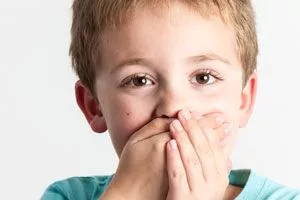 Toothache: Clean the area of the affected tooth. Rinse thoroughly with warm water or use dental floss to remove food particles in the area. Contact your child’s dentist if the pain persists.
Toothache: Clean the area of the affected tooth. Rinse thoroughly with warm water or use dental floss to remove food particles in the area. Contact your child’s dentist if the pain persists.
Avoid putting aspirin or heat on the gums or aching tooth. Use cold compresses to reduce facial swelling and contact your dentist immediately.
Cut or Bitten Tongue, Lip, or Cheek: Apply ice to injured areas to help minimize swelling. Apply firm but gentle pressure with a gauze or cloth to treat bleeding. If simple pressure does not control the bleeding, call a doctor or visit the hospital emergency room.
Knocked Out Permanent Tooth: If you can find the tooth, hold it only by the crown, not the root. Rinse the tooth with water only, NOT soap. Be gentle with the tooth. DO NOT scrub or handle it unnecessarily.
Check the tooth for fractures. If the tooth is okay, try to reinsert it in the socket. Have the patient bite on gauze to hold the tooth in place.
If the tooth cannot be reinserted, place it in a cup with the patient’s saliva or milk, NOT water. If the patient is old enough, the tooth may also be held in place inside the cheek. The patient must see a dentist IMMEDIATELY! Time is a critical factor.
Knocked Out Baby Tooth: Contact your dentist. Unlike a permanent tooth, the baby tooth should not be replanted because there may be damage to the developing permanent tooth. Usually, no treatment is necessary.
Chipped/Fractured Permanent Tooth: Time is critical. Contact your dentist immediately to lessen the risk of infection or the possibility of extensive future dental treatment. Rinse the mouth and apply a cold compress to minimize any swelling. If it is possible to find the broken tooth piece, bring it with you to the dentist.
Chipped/Fractured Baby Tooth: Call your dentist.
Severe Blow to the Head: Call 911 immediately or go to the nearest hospital emergency room.
Possible Broken or Fractured Jaw: Keep the jaw stable and take your child to the nearest emergency room.
Read more about how to prevent dental emergencies during recreational activities and sports in the resource section on mouth guards.
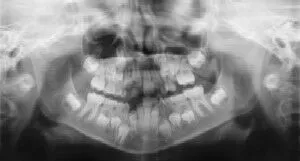
Radiographs (X-Rays) are vital for your child’s oral health care. Certain dental conditions can be missed without x-rays.
Radiographs detect much more than cavities. They are used to check erupting teeth, diagnose bone diseases, evaluate an injury, and plan orthodontic treatment. With x-rays, dentists are able to diagnose and treat health conditions that otherwise cannot be detected during a routine dental examination. Dental problems that are found and treated early result in more comfortable, affordable dental care.
The American Academy of Pediatric Dentistry recommends radiographs and dental exams every six months for children with a high risk of tooth decay. Most children’s dentists request x-rays once a year. Every 3 years a complete set of radiographs may be taken. This may involve a panoramic and bitewings or periapicals and bitewings.
Children’s dentists take precautions to minimize their patients’ exposure to radiation. With contemporary safeguards, the amount of radiation received with a dental x-ray is extremely small. The risk is negligible. In fact, the risk from dental radiographs is smaller than that of an undetected, untreated dental problem.
We use lead body aprons and shields to protect your child. Today’s equipment filters out unnecessary x-rays and restricts the x-ray beam to the treatment area. Using high-speed film and proper shielding techniques make sure that your child receives minimal radiation exposure.
 Toothbrushing is an important habit for good oral health. Many toothpastes contain harsh abrasives which can wear away tooth enamel and damage young smiles. Choose a children’s toothpaste that is recommended by the American Dental Association. These toothpastes have undergone testing to ensure their safety.
Toothbrushing is an important habit for good oral health. Many toothpastes contain harsh abrasives which can wear away tooth enamel and damage young smiles. Choose a children’s toothpaste that is recommended by the American Dental Association. These toothpastes have undergone testing to ensure their safety.
Use only a tiny amount of toothpaste (about the size of a grain of rice) to brush the teeth of a child less than 3 years old. Children 3 to 6 years old should use a “pea-sized” amount of toothpaste. At this age, parents should perform or assist in toothbrushing.
Remember, young children are unable to brush their teeth effectively on their own. Make sure your child spits out and does not swallow excess toothpaste after brushing.
Parents are often concerned about nighttime grinding of teeth (bruxism). In many cases, the first sign of bruxism is the noise created when the child grinds his/her teeth during sleep. The parent may also notice wear on the teeth or the teeth getting shorter.
One possible cause of teeth grinding involves a psychological component. This may stem from stress due to a new environment, divorce, changes at school, etc.
Another theory relates to inner ear pressure at night. During pressure changes, like during take-off and landing in an airplane, when people chew gum to equalize pressure, the child may grind by moving his jaw to relieve this pressure.
Most bruxism cases do not require any treatment. However, a mouth guard or night guard may be recommended if there is excessive wear on the teeth (attrition).
If a mouth guard becomes dislodged during sleep, it may cause choking. The appliance may also interfere with growth of the jaws. The advantage of a mouth guard is that it prevents wear to the primary dentition.
The good news is most children outgrow bruxism. The grinding decreases between the ages 6-9 and usually stops altogether between ages 9-12. If you suspect bruxism, discuss the issue with your pediatrician or dentist.
 Sucking is a natural reflex as you will see infants, toddlers, and young children suck their thumbs, fingers, pacifiers, and other objects. It may provide a sense of security and make them feel happy. Thumb sucking is relaxing and may induce sleep.
Sucking is a natural reflex as you will see infants, toddlers, and young children suck their thumbs, fingers, pacifiers, and other objects. It may provide a sense of security and make them feel happy. Thumb sucking is relaxing and may induce sleep.
If thumb sucking continues after the permanent teeth begin to erupt, it can cause problems with the proper growth of the mouth and tooth alignment. How intensely a child sucks on fingers or thumbs may determine if dental problems result. Children who simply rest their thumbs passively in their mouths are less likely to have major problems than those who vigorously suck their thumbs.
Children should stop sucking their thumbs by the time their permanent front teeth are ready to erupt. Although most children stop this habit between the ages of two and four, peer pressure can cause school-aged children to stop.
Pacifiers can affect the teeth the same way and should not be considered a substitute for thumb sucking. However, a pacifier is easier to control or modify than sucking the thumbs or fingers. If you have concerns about a child who sucks his/her thumb or pacifier, consult your dentist.
To help your child stop his/her thumb sucking habit, consider the following tips:
-
- Children often suck their thumbs when feeling insecure. Focus on addressing the cause of anxiety, rather than the thumb sucking itself.
- Children who are sucking for comfort are less likely to do so when their parents provide comfort.
- For children who suck for comfort during difficult periods such as being separated from parents, provide rewards when your child refrains from sucking.
- Your dentist can encourage children to stop sucking and explain the dental consequences if they continue.
- If the above options do not work, try bandaging the thumb or placing a sock on the hand at night. The patient’s dentist may recommend a mouth appliance.
The tooth’s pulp is the inner, central core where the blood vessels, nerves, connective tissue, and reparative cells are housed. Pulp therapy strives to maintain the vitality of the affected tooth so the tooth is not lost.
Dental caries (cavities) and traumatic injury are the most common reasons a tooth may require pulp therapy. Pulp therapy is also called a “nerve treatment,” “children’s root canal,” “pulpectomy,” or “pulpotomy.” Pulpotomy and pulpectomy are the two common types of pulp therapy for children’s teeth.
A pulpotomy removes the diseased pulp tissue within the crown of the tooth. Next, a substance is placed to keep bacteria from growing and to calm the remaining nerve tissue. Then, the final restoration, usually a stainless steel crown, is placed on top.
A pulpectomy is required when the entire pulp, even into the root canal(s) of the tooth, is involved. The treatment involves removing the diseased pulp tissue from the crown and root. The canals are cleansed and disinfected.
A primary tooth is filled with a resorbable material before the final restoration is placed. A permanent tooth is filled with a non-resorbable material.
 A bad bite, or malocclusion, can be recognized as early as 2-3 years of age. Often, early steps help reduce the need for major orthodontic treatment later.
A bad bite, or malocclusion, can be recognized as early as 2-3 years of age. Often, early steps help reduce the need for major orthodontic treatment later.
Stage I – Early Treatment: This stage involves treatment during ages 2 to 6 years. At such a young age, dentists/orthodontists are focused on underdeveloped dental arches, losing baby teeth too early, and bad habits such as finger or thumb sucking. Early treatment is often very successful and many times eliminates the need for future orthodontic/orthopedic treatment.
Stage II – Mixed Dentition: Stage II covers children ages 6 to 12 years who have erupting permanent incisor (front) teeth and 6-year molars. Treatment addresses abnormal jaw relationships and dental realignment problems. When needed, this is an excellent stage to start treatment because the child’s hard and soft tissues are often very responsive to orthodontic or orthopedic forces.
Stage III – Adolescent Dentition: The third stage addresses the permanent teeth and the final bite relationship.
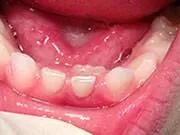 This is a very common occurrence with children. It usually occurs when a lower, primary (baby) tooth does not fall out and the permanent tooth is coming in.
This is a very common occurrence with children. It usually occurs when a lower, primary (baby) tooth does not fall out and the permanent tooth is coming in.
In most cases, if the child starts wiggling the baby tooth, it will usually fall out on its own within two months. If it doesn’t, then contact your child’s dentist, who can easily remove the tooth. The permanent tooth should then slide into the proper place.
Early Infant Oral Care
 Research shows periodontal disease may increase the risk of pregnancy problems such as preterm birth and low birth weight. If you have concerns, discuss periodontal disease prevention with your doctor or dentist.
Research shows periodontal disease may increase the risk of pregnancy problems such as preterm birth and low birth weight. If you have concerns, discuss periodontal disease prevention with your doctor or dentist.
Additionally, mothers who have poor oral health have an increased risk of passing cavity-causing bacteria to their young children. Mothers should adhere to the following steps to reduce the risk of spreading cavity-causing bacteria:
-
- Keep regular dental appointments.
- Brush and floss daily to reduce plaque and bacteria.
- Maintain a proper diet that reduces the amount of beverages and foods high that are in sugar & starch.
- Use an ADA recommended fluoridated toothpaste. Rinse nightly with an alcohol-free mouthwash with .05 % sodium fluoride.
- Don’t share utensils, cups, or food with your children.
- Use of xylitol chewing gum by the mother (4 pieces per day) can decrease a child’s caries rate
The American Academy of Pediatrics (AAP), the American Dental Association (ADA), and the American Academy of Pediatric Dentistry (AAPD) recommend establishing a “dental home” for your child by age one. When children have a dental home, they are more likely to receive proper preventive and routine oral care.
Your child’s dental home provides a place for parents to turn other than the Emergency Room.
As the parent, you play a role in making the first visit to the dentist a positive one. If your child is old enough, discuss the visit with them. Explain that the dentist and dental staff will explain all procedures and answer any questions. Do not make a big to-do concerning the visit.
Refrain from using words that may create unnecessary fear, such as needle, pull, drill, or hurt. Pediatric dental offices try to use pleasant, non-frightening words that convey the same message.
Teething is the process of primary, or baby, teeth erupting through the gums. The timing is variable among babies. Some babies get their teeth early; others get them late. Generally, the first baby teeth to erupt are the lower front (anterior) teeth which usually come through between the age of 6-8 months.
For more information, review the section on “Eruption of Your Child’s Teeth.”
 Baby bottle tooth decay is one serious type of decay among young children. This results when an infant’s teeth are frequently exposed to liquids that contain sugar. The liquids include milk, breast milk, formula, fruit juice, and other sweetened drinks.
Baby bottle tooth decay is one serious type of decay among young children. This results when an infant’s teeth are frequently exposed to liquids that contain sugar. The liquids include milk, breast milk, formula, fruit juice, and other sweetened drinks.
Putting a baby down to sleep with a bottle that contains something other than water can cause serious and rapid tooth decay. When sweet liquid pools around the child’s teeth, plaque bacteria has a chance to produce acids that attack tooth enamel.
If you must give the baby a bottle for comfort at bedtime, it should only contain water. If your child won’t fall asleep without the bottle and its usual contents (milk, formula, etc.), gradually dilute the usual liquid with water over a period of two to three weeks.
After each feeding, use a damp washcloth or gauze to wipe the baby’s gums and teeth. You may do this by sitting down with your child’s head in your lap or by laying the child on a dressing table or the floor. Make sure you can easily see into your child’s mouth.
Sippy cups should be used to transition the child from the bottle to a cup. They should be discontinued by the first birthday. If your child does use a sippy cup, fill the sippy cup with water for drinking throughout the day and milk or other liquids for mealtimes. When a child drinks from a sippy cup filled with liquids that contain sugar (including milk, fruit juice, sports drinks, etc.) throughout the day, it soaks the child’s teeth with cavity-causing bacteria.
Prevention
Brushing Tips:
- As soon as your baby’s teeth come through, brush them using a soft-bristled toothbrush.
- For children under 2, apply a small “smear” of toothpaste.
- For 2-5-year-olds, brush with a “pea-sized” amount of toothpaste.
- Only use an ADA-accepted fluoride toothpaste and do not let your child swallow the toothpaste.
- As the parent, you should brush your child’s teeth until they can adequately brush on their own.
Flossing Tips:
- Flossing removes plaque and food particles from between the teeth and under the gumline where a toothbrush can’t reach.
- Begin flossing your child’s teeth when they start to touch.
- Floss your child’s teeth daily until he or she can do it independently.
 Healthy eating habits lead to healthy teeth. The teeth, bones, and the soft tissues of the mouth benefit from a well-balanced diet. For proper growth and development, children should eat foods from the five major food groups.
Healthy eating habits lead to healthy teeth. The teeth, bones, and the soft tissues of the mouth benefit from a well-balanced diet. For proper growth and development, children should eat foods from the five major food groups.
Snacks can lead to cavity formation. Frequent snacks increase the chance of tooth decay. The length of time that food remains in the mouth also plays a role.
For example, hard candy and mints do not dissolve quickly but stay in the mouth for a long time. This allows for longer acid attacks on tooth enamel. Choose nutritious snacks such as vegetables, low-fat yogurt, and low-fat cheese, which are healthier and better for children’s teeth.
Good oral health habits are necessary to remove bacteria and leftover food particles that may combine to create cavities. For infants, wipe plaque from the teeth and gums using a clean, damp washcloth or gauze pad. Do not put your child to sleep with a bottle, unless it is only filled with water. For more information, check out “Baby Bottle Tooth Decay.”
For older children, brush their teeth at least twice per day. Also, limit the number of sugar-containing snacks that you give your children.
The American Academy of Pediatric Dentistry recommends dental visits every six months, starting when your child turns 1. Routine dental exams start your child on a lifetime of good dental health.
The dentist may suggest protective sealants or fluoride treatments. Sealants are applied to your child’s molars to prevent decay on the biting surfaces.
A sealant is a protective coating that the dentist or hygienist applies to the chewing surfaces or the premolars and molars. This is where four out of five cavities in children are found. This creates a barrier to food, plaque, and acid, so the decay-prone areas of the teeth are protected.
Fluoride is a naturally-occurring element that studies have shown may prevent tooth decay by 50-70%. However, too little or too much fluoride can cause problems for the teeth. Too little fluoride leaves the teeth weak and unable to resist cavities.
When young children ingest too much fluoride, it can cause dental fluorosis. This results in a chalky white discoloration (brown in advanced cases) of the permanent teeth. Adhere to your dentist’s instructions regarding fluoride use and possible supplements.
Protect your child’s teeth by brushing his/her teeth with a fluoride toothpaste. Use only a smear of toothpaste for children under 3 years old and a pea-sized amount for children ages 3-6.
Perform or help your child brush his/her teeth. Remember, young children cannot brush their teeth effectively on their own. Children should spit out, not swallow excess toothpaste after brushing, in order to avoid fluorosis.
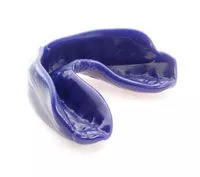 Injuries are possible from participation in recreational activities and organized sports. A properly fitted mouth guard is crucial in athletics to protect your child’s smile. It should be used during any activity involving physical contact that could result in a blow to the face or mouth.
Injuries are possible from participation in recreational activities and organized sports. A properly fitted mouth guard is crucial in athletics to protect your child’s smile. It should be used during any activity involving physical contact that could result in a blow to the face or mouth.
Mouth guards reduce injuries to the lips, tongue, face, and jaw and prevent broken teeth. A properly fitted mouth guard stays comfortably in place so your child can easily talk and breathe.
Ask us about custom or store-bought mouth guards.
The American Academy of Pediatric Dentistry (AAPD) notes that xylitol is beneficial for maintaining the dental health of infants, children, adolescents, and patients with special health needs.
Mothers who used XYLITOL GUM 2-3 times daily from the time the child was 3 months old until 2 years old showed up to a 70% reduction in cavities when the child was 5 years old.
Studies in which xylitol was a sugar substitute or addition to the diet have shown dramatic reductions in new tooth decay and some reversal of existing dental cavities. Xylitol gives additional protection for oral health that enhances all existing cavity prevention methods. The effect is long-lasting and may be permanent. Low decay rates continue even years after the trials have been completed.
Xylitol is found in small amounts throughout nature. Good sources of xylitol include fruits, berries, mushrooms, lettuce, hardwoods, and corn cobs. One cup of raspberries has less than one gram of xylitol.
Studies with positive results from xylitol intake involved using 4-20 grams per day, consumed in 3-7 periods. Increased amounts did not show greater reduction and may lead to diminishing results. Similarly, reduced consumption frequency showed no effect.
For gum or other xylitol-containing products, visit your local health food store or check online to find products containing 100% xylitol.
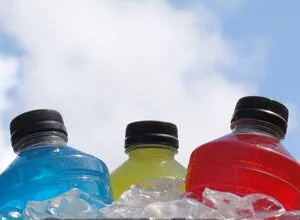 Sports drinks contain a high amount of sugar and acids. This gives the drinks erosive potential and the ability to dissolve even fluoride-rich enamel, which can lead to cavities.
Sports drinks contain a high amount of sugar and acids. This gives the drinks erosive potential and the ability to dissolve even fluoride-rich enamel, which can lead to cavities.
To minimize dental problems, children should avoid sports drinks and instead use water to hydrate before, during, and after sports. Discuss sports drinks with your dentist before use.
If sports drinks are consumed, follow these tips:
- Reduce the frequency of the drinks and the contact time.
- Swallow the liquid immediately without swishing it around the mouth.
- Help neutralize the effect of sports drinks by alternating sips of water with the drink.
- Rinse mouth guards with water only.
- Seek out dental-friendly sports drinks.
